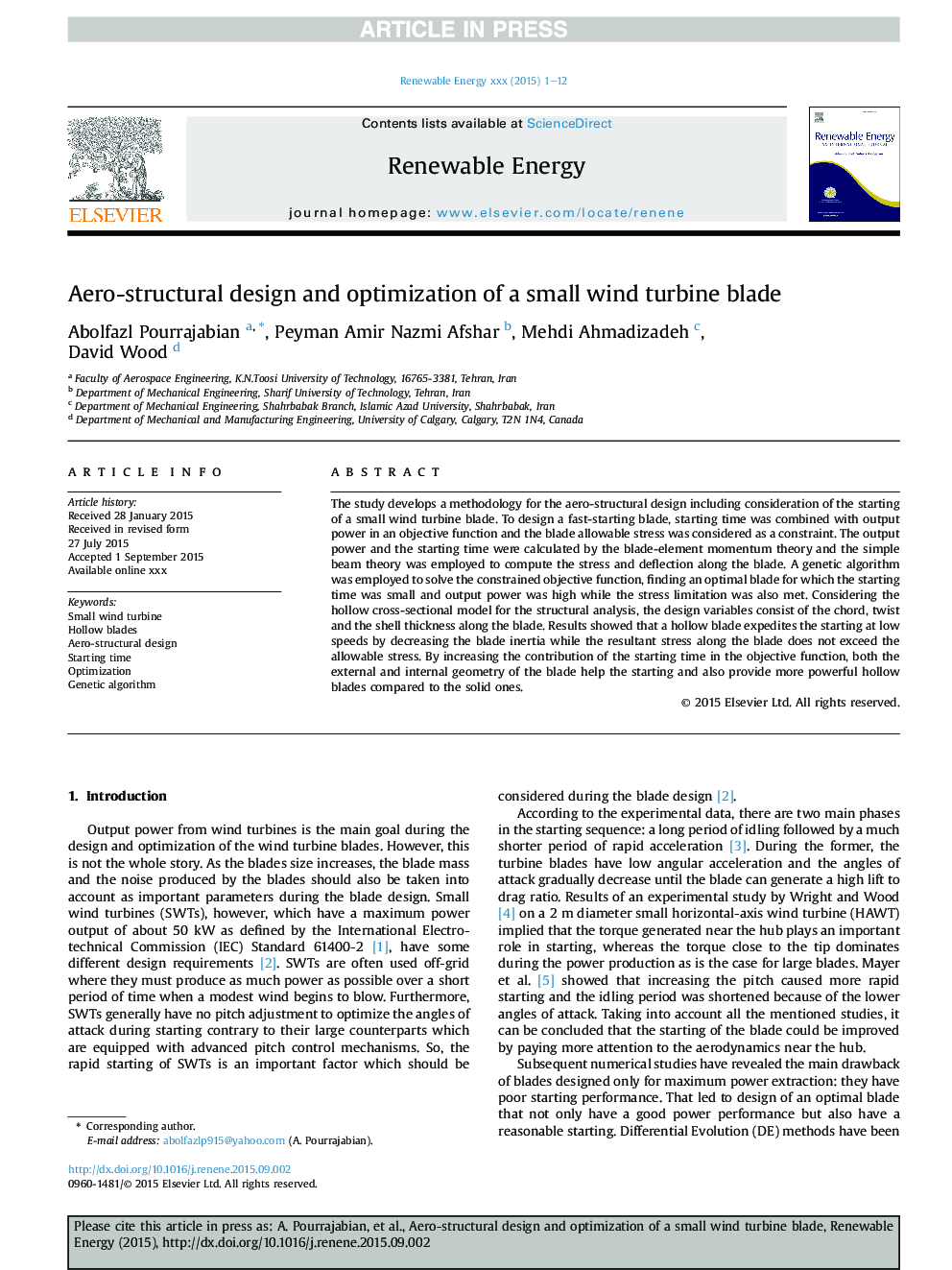| کد مقاله | کد نشریه | سال انتشار | مقاله انگلیسی | نسخه تمام متن |
|---|---|---|---|---|
| 10294028 | 512450 | 2016 | 12 صفحه PDF | دانلود رایگان |
عنوان انگلیسی مقاله ISI
Aero-structural design and optimization of a small wind turbine blade
ترجمه فارسی عنوان
طراحی هوائی ساختاری و بهینه سازی یک توربین بادی کوچک
دانلود مقاله + سفارش ترجمه
دانلود مقاله ISI انگلیسی
رایگان برای ایرانیان
کلمات کلیدی
توربین بادی کوچک، تیغه های توخالی، طراحی هوائی، زمان شروع، بهینه سازی، الگوریتم ژنتیک،
ترجمه چکیده
این مطالعه روش شناسی طراحی هواپیمائی را با توجه به شروع یک تیغه توربین بادی کوچک، توسعه می دهد. برای طراحی یک تیغه سریع شروع، زمان شروع با قدرت خروجی در یک تابع هدف ترکیب شد و تنش مجاز تیغه به عنوان یک محدودیت در نظر گرفته شد. قدرت خروجی و زمان شروع با استفاده از تئوری تسلیم عنصر تیغه محاسبه و تئوری ساده پرتو برای محاسبه استرس و انحراف در طول تیغه استفاده شد. الگوریتم ژنتیکی برای حل تابع هدف محدود شده، پیدا کردن یک تیغه بهینه که زمان شروع آن کوچک بود و قدرت خروجی بالا بود در حالی که محدودیت استرس نیز برآورده شد. با توجه به مدل مقطعی توخالی برای تجزیه و تحلیل ساختاری، متغیرهای طراحی شامل وتر، پیچ و ضخامت و ضخامت پوسته در طول تیغه است. نتایج نشان داد که یک تیغه توخالی با پایین آوردن سرعت چرخش در سرعت های پایین، در حال کاهش استوانه تیغه است، در حالی که استرس در طول تیغه از استرس قابل قبول تجاوز نمی کند. با افزایش سهم زمان شروع در تابع هدف، هر دو هندسه خارجی و داخلی تیغه به شروع شروع می شوند و همچنین تیغه های توخالی بیشتری را نسبت به اجسام جامد ارائه می دهند.
موضوعات مرتبط
مهندسی و علوم پایه
مهندسی انرژی
انرژی های تجدید پذیر، توسعه پایدار و محیط زیست
چکیده انگلیسی
The study develops a methodology for the aero-structural design including consideration of the starting of a small wind turbine blade. To design a fast-starting blade, starting time was combined with output power in an objective function and the blade allowable stress was considered as a constraint. The output power and the starting time were calculated by the blade-element momentum theory and the simple beam theory was employed to compute the stress and deflection along the blade. A genetic algorithm was employed to solve the constrained objective function, finding an optimal blade for which the starting time was small and output power was high while the stress limitation was also met. Considering the hollow cross-sectional model for the structural analysis, the design variables consist of the chord, twist and the shell thickness along the blade. Results showed that a hollow blade expedites the starting at low speeds by decreasing the blade inertia while the resultant stress along the blade does not exceed the allowable stress. By increasing the contribution of the starting time in the objective function, both the external and internal geometry of the blade help the starting and also provide more powerful hollow blades compared to the solid ones.
ناشر
Database: Elsevier - ScienceDirect (ساینس دایرکت)
Journal: Renewable Energy - Volume 87, Part 2, March 2016, Pages 837-848
Journal: Renewable Energy - Volume 87, Part 2, March 2016, Pages 837-848
نویسندگان
Abolfazl Pourrajabian, Peyman Amir Nazmi Afshar, Mehdi Ahmadizadeh, David Wood,
